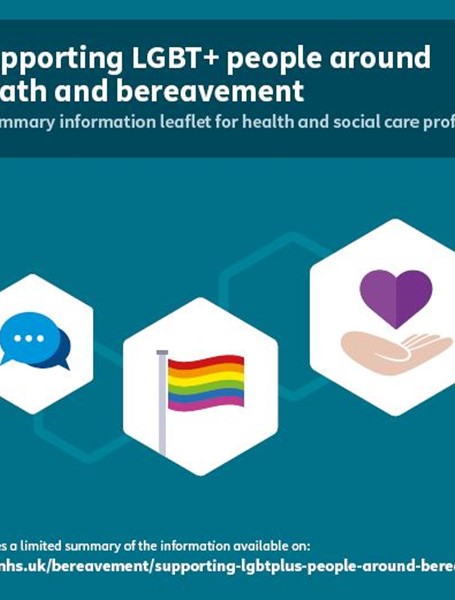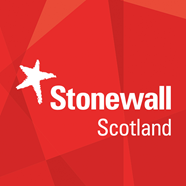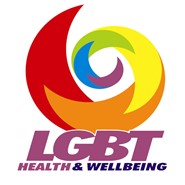When caring for people who are LGBT+ at the end of life or when supporting LGBT+ people around bereavement, there are some particular considerations to be aware of.
It may not be evident or known that a person is LGBT+ so it is important that care is delivered, and communication conducted, in a way that is inclusive, affirmative, respectful and avoids making assumptions. (This page focuses on bereavement rather than care before death).
Fears about death and bereavement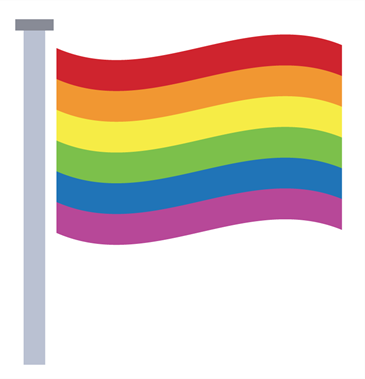
People who are LGBT+ may have particular fears regarding death and bereavement. These include:
-
Fear of being outed in death, e.g.
- 14% of trans and 24% of non-binary people are not out to anyone in their family
- 11% of trans people who are out to family, aren't supported by any family members [1]
-
Fear of inappropriate curiosity regarding themselves or their body
-
Fear about who will be handling their body after death, and concern that they will be treated with a lack of respect
-
Fear of having to hide sexual orientation or gender identity
-
Fear that their relationships or gender will not be acknowledged
-
Fear of being misgendered (e.g. at death registration), deadnamed and misremembered perhaps due to a:
- lack of certain legal documentation
- lack of support from their relatives
- lack of recent contact with their relatives
- disagreement, lack of acquaintance or awareness between their chosen family and family in which they were raised
-
Fear about who will organise the funeral or memorial service and that these will not be in keeping with their wishes
-
Concerns regarding the safety of mourners who will wish to attend the funeral or memorial service
A UK survey of lesbian, gay and bisexual adults revealed that “24% expected to face barriers relating to their sexual identity when planning a funeral” (Bristowe et al, 2016).
[1] YouGov survey for Stonewall, LGBT Britain: Trans Report, Stonewall, 2018, p14.
Supporting LGBT+ People Around Death & Bereavement
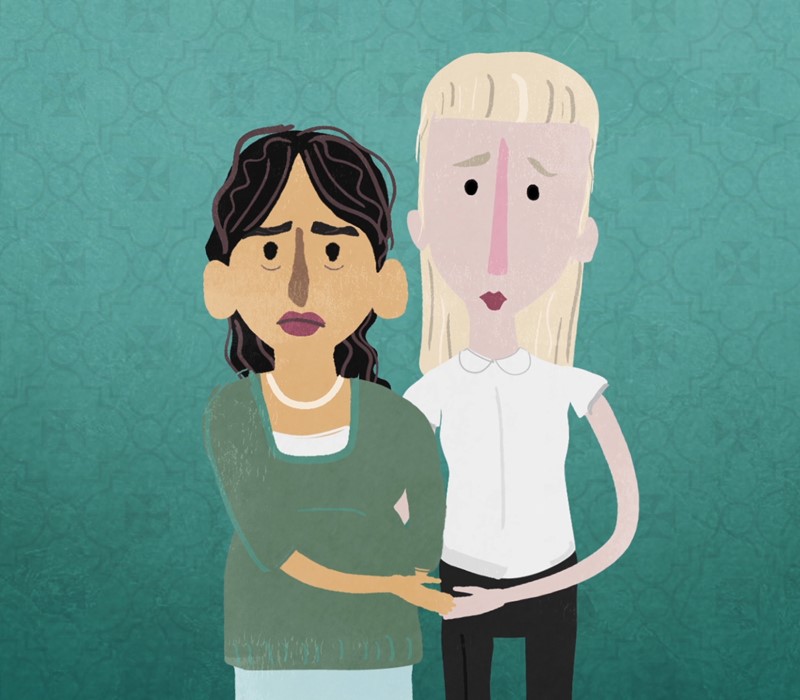
How to talk about an LGBT+ person who has died
Do not disclose a person’s sexual orientation or trans status unless you have their permission, or it is need-to-know information; inappropriate disclosure could be an offence under equalities legislation.
Refer to the person as they referred to themselves, echoing the words they used, e.g.
-
Gender: Woman, man, non-binary person etc.
-
Pronouns: he/him, she/her, they/them, ze/zir
-
Title: Ms, Mr, Miss, Mrs, Mx, M
-
Gender marker: M, F, or an alternative e.g. X (if possible)
These may not all “match” traditional understandings (e.g. a trans man could use they/them, the gender marker M, and the title Mx), so it is worthwhile considering each of these separately.
If you don’t know how to refer to the person who has died, it may be most appropriate to be guided by the language those closest to them use, or by asking:
-
“how would X have wanted to be referred to” or
-
“how would X have described their gender?”
Use your discretion in terms of echoing the language that relatives use, if you think this may not reflect the language of the person who has died.
Experiences of bereavement for LGBT+ partners
Interactions with staff around the time of a death can have a profound effect on a partner’s bereavement experience, positively or negatively. Avoid the assumption that someone is a friend, instead ask how they knew the deceased; e.g.
-
“How would you and X describe your relationship?”
-
Asking, e.g. “Who was important to X?” can also be helpful
Particularly for older LGBT+ people accessing services, prior experience of stigma and pathologisation in professional or institutional settings means that there may be considerable barriers to being ‘out’ in those environments. This can lead to re-entering the closet and / or experiencing decreased mental wellbeing at a time of increased vulnerability, such as in bereavement.
Examples of situations which can impact negatively on an LGBT+ partner:
-
Lack of acknowledgement of the relationship e.g. the presumption that they are a friend rather than a partner
-
Exclusion from discussions and decision making
-
Being prevented from being with their partner at end of life
-
Being prevented from seeing the person's body after death
-
Being denied an opportunity to say goodbye
-
Being unable to access bereavement support
-
Seeing their partner be misgendered or deadnamed
Recognition of a partner’s needs and asking about their wellbeing can be a source of great support for individuals. Sensitively explore a person’s identity in line with their preferences for disclosure and consider signposting LGBT+ partners to additional sources of bereavement support. Social isolation and loneliness can be compounded when coping with bereavement in the absence of LGBT+ affirmative support.
Managing relationships between families of origin and chosen families
After an LGBT+ person dies, staff may need to liaise, share information and support different groups of people who knew the deceased. This can require careful and considered communication. When engaging with a person’s identified legal next of kin, do not assume that they are a blood relative, legal relative, or married partner.
LGBT+ people are more likely to be estranged from their families of origin. Where contact and ties do exist, these may be fragile, distant or difficult relationships. Some families may not know anything about the deceased person’s LGBT+ status; or alternatively, a person may have been ‘out’ to their family to different degrees. They may have had varying levels of comfort in disclosing details about their sexual orientation or gender identity. These factors can cause additional stress to those who are bereaved.

Chosen family may welcome particular support in engaging with the deceased person’s family of origin. They may wish to avoid being outed, and / or they may be keen to ensure they can play an important role in handling the practical matters following death.
Staff may also receive requests for information from within a person’s community. This may be particularly prevalent if the person died without a partner or close relatives, or if the community is aware that they had an LGBT+ identity that should be respected. Although Data Protection Act does not apply after death, these requests can be challenging for staff to manage. It is important to ensure that clinical confidentiality, which is a professional responsibility, is maintained, while also acknowledging the importance of trying to enable those who are bereaved to honour the deceased and participate in grieving rituals. There are circumstances where relevant clinical information can be disclosed - see: The General Medical Council Guidance to doctors about disclosing information after a patient has died.
In some situations, a person’s chosen family or community may not feel comfortable or safe to attend a funeral or memorial service. In this and other scenarios, relatives and chosen families may choose to hold separate services or commemorations.
Death in the LGBT+ community
Trans people in particular have been noted to have a higher rate of sudden death and also face higher rates of depression and anxiety, suicidal ideation and suicide. [2] This, compounded with the lasting effects of the HIV/AIDS crisis, means that the trans community do not have many older trans role models and many trans people cannot imagine themselves growing old.
Key points for staff
-
LGBT+ people and their partners may have particular fears about death and bereavement
-
Take a person centred approach and do not make assumptions about a person’s sexual orientation, gender or relationship status
-
Interactions with staff can shape experiences of bereavement - be sensitive (a bereaved partner may be expecting to face discrimination) and foster trust and empathy which will make it easier for people to discuss and disclose their needs
-
Use neutral and inclusive language e.g. ‘partner’ and pronouns that the deceased person had chosen for themselves
-
Acknowledge and affirm the relationships that the deceased person had. Consider the wellbeing of a person’s partner; ensuring that discussion and decision-making includes them (when appropriate) and signposting them to appropriate sources of bereavement support
-
Be aware that relationships between those who are bereaved may be complicated and non-harmonious
-
Clinical confidentiality regarding a person’s LGBT+ status must be maintained in line with legal regulations after a death, noting that there may be situations where information sharing is necessary
-
Where possible, communicate with, and support all those who are bereaved (e.g. next of kin, the family in which a person was raised, chosen families and a person’s community) in line with confidentiality restrictions
Additional information:
-
Sexual orientation in Scotland, 2017: summary of evidence base, Scottish Government
-
LGBT+ in Britain, Health Report, Stonewall, 2018
-
Bereavement: A guide for Transsexual, Transgender people and their loved ones, Department of Health Report, 2007
-
Enough for everyone: Challenging inequalities in palliative care, Marie Curie, 2016
-
“Hiding who I am”, The reality of end of life care for LGBT+ people, Marie Curie, 2016
- The Last Outing: LGBT+ People’s Attitudes Towards End Of Life Care, University of Nottingham, 2015
- Unhealthy Attitudes Scotland: The treatment of LGBT+ people within health and social care organisations in Scotland, Stonewall Scotland, 2015
- Your Services, Your Say: LGBT+ People's Experiences of Public Services in Scotland, Stonewall Scotland, 2014
- Trans healthcare, General Medical Council
- The Route to Success in End of Life Care: achieving quality for lesbian, gay, bisexual and transgender people, NHS National End of Life Care Programme, 2012
Content produced with support from
References
[1] https://www.stonewall.org.uk/resources/lgbt-britain-trans-report-2018
[2] https://www.stonewall.org.uk/resources/lgbt-scotland-health-2018
